The ‘Cape Malay’ community is rich in culture and religious traditions that have played a major role in shaping the history and diversity of Cape Town.
Origins
The exploration of the African continent in the fifteenth century and the colonization of South East Asia in the sixteenth century by European powers led to the enslavement of millions of Afro-Asian peoples. European powers exploited ethnic differences by employing the divide and rule tactic and used military conquest to subdue resistance by the local inhabitants. As a consequence Europeans exercised almost total control over virtually of these two continents. One of the reasons linked to colonial expansion in Africa and Asia was trade and the search for new markets. The need for labour to sustain trade created a massive international slave trade which led to the involuntary migration of large numbers of Africans and Asians to different parts of the world. For instance it is estimated that Africa alone supplied some 20 million slaves over three centuries in order to satisfy the American demand for labour.
Although slavery and the slave trade flourished off the coast of West and East Africa, Southern Africa remained largely untouched. This changed after the VOC established their presence at the Cape. Dutch settlers at the Cape of Good Hope arrived in 1652 when Jan van Riebeeck came to the Cape to establish a trading post and supply fort for trading vessels plying the Europe-East Indies route. The Dutch settlers were given land and required to produce enough food to meet the supply needs of the VOC ships and the settlement. Settlers or ‘free burgers’ that were granted land demanded cheap labour in order for them to produce enough supplies. The VOC used this as an opportunity to import political exiles from the East Indies to work as slaves in the Cape Colony.
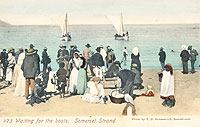 The Malays waiting for the boats at Somerset Strand. Source: Franco Frescura Collection.
The Malays waiting for the boats at Somerset Strand. Source: Franco Frescura Collection.
The VOC which colonised portions of South East Asia and practiced slavery introduced the system to the Cape. Those people that opposed the colonization and occupation of their lands by the Dutch were taken as political prisoners or shipped to exile at the Cape of Good Hope as slaves. The first slaves arrived in the latter half of the seventeenth century with the initial load coming from Africa. Their ship was captured by the Dutch from a Portuguese ship destined for Brazil. However, the majority of slaves were gradually brought to the Cape from the Dutch East Indies in Asia by the Dutch. A large majority of those being brought were Muslims, were captured and sent into exile from colonies such as Madagascar, India, Ceylon and the Dutch East Indies (known as Indonesia today). Other immigrants were from Philippines, Japan, Macau, Malacca, West Indies, Brazil and possibly New Guinea.
The origins of this migration can be traced to early in the sixteenth century when, at the end of Indonesia's Majapahit Kingdom, European military penetration and anti-Islamic persecution caused resistance which was crushed by the Dutch. This led to many opponents of the Dutch being exiled to the Cape of Good Hope in southern Africa, which was also occupied by them. Some were also brought or captured from English, French and Portuguese ships. Included in this group were the Malay servants of the Dutch officials who were on their way back to the Netherlands from the East. The main group of African immigrant’s came from East Africa, Madagascar and West Africa. Many of these people were skilled artisans, such as silversmiths, milliners, cobblers, singers, masons and tailors. This group came to be known collectively as the ‘Cape Malay,’ despite their diverse origins as far afield as East Africa and Malaysia.
Anyone who opposed the colonization of their countries would be taken as political prisoners or exiles. It was one such group of people that were brought to the Cape of Good Hope. The first of these migrants arrived in the latter half of the seventeenth century, mainly from colonies in Africa and Asia that were occupied by the Dutch and the British.
The large majority being Muslims, were captured and sent into exile from colonies such as Madagascar, India, Ceylon and the Dutch East Indies (Indonesia as we know it today). Some immigrants were from Philippines, Japan, Macau, Malacca, West Indies, Brazil and possibly New Guinea. Some were also brought or captured from English, French and Portuguese ships. Included in this group were the Malay servants of the Dutch officials who were on their way back to the Netherlands from the East.
The main group of African immigrant’s came from East Africa, Madagascar and West Africa.
The origins of this migration can be traced to early in the sixteenth century when, at the end of Indonesia's Majapahit Kingdom, European military penetration and anti-Islamic persecution caused resistance which was crushed by the Dutch. This led to many opponents of the Dutch being exiled to the Cape of Good Hope in southern Africa, which was also occupied by them.
The first Dutch settlers at the Cape of Good Hope arrived in 1652, when Jan van Riebeeck came to the Cape to establish a trading post and supply fort for trading vessels plying the Europe-East Indies route.
The Dutch required labour and utilised the opportunity to import political exiles from the East Indies as slaves. Many of these people were skilled artisans, such as silversmiths, milliners, cobblers, singers, masons and tailors. This group came to be known collectively as the 'Cape Malay,' despite their diverse origins as far afield as East Africa and Malaysia.
Orang Cayen - Men of Repute
Sheikh Yusuf
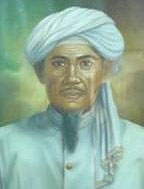 A portrait of Sheikh Yusuf
A portrait of Sheikh Yusuf
One prominent figure among the exiles, or Orang Cayen (Men of Repute), who resisted the Dutch occupation of the East Indies, was Sheikh Yusuf al-taj alkhalwatial-Maqasari. Credited with having brought Islam to South Africa, Sheikh Yusuf was born in 1626 in Goa on the island of Celebes (today known as Sulawesi). Sheikh Yusuf was the son of Makassarese nobility, and the nephew of King Bissu of Goa.
Sheikh Yusuf spent several years studying Arabic and traditional religious sciences in Mecca. He eventually returned to Banten, West Java, where he taught the Islamic doctrine of "Khalwatiyyah", which he had learned during his years spent in Mecca.
He eventually joined forces with Sultan Ageng in his fight against the Dutch attempts to gain complete control of the Sultanates in the East Indies. In 1683, Sheikh Yusuf was captured and exiled to Ceylon and eventually brought to the Cape of Good Hope. On 2 April 1694, Sheikh Yusuf, together with 49 other Muslim exiles from the East Indies arrived at the Cape aboard the ship “de Voetboeg.”
Sheikh Yusuf, his family and followers were sent to Zandvliet farm at the mouth of the Eerste River, just outside Cape Town, to prevent his influence on the Islamic slave population. It is ironical that this farm had belonged to a minister of the Dutch Reformed Church, the Rev Petrus Kalden. Under the leadership of Sheikh Yusuf, who was 68 years of age at the time, the group at Zandvliet established one of the first elementary structures of a Muslim community. Dutch attempts to isolate them failed as Zandvliet became a gathering spot for Muslims and a rallying point for runaway slaves, and other exiles from the East. This farm area is now known as Macassar. As Sheikh Yusuf's influence and spiritual teachings spread widely amongst the slaves at the Cape, they came to represent one of the first areas of resistance to colonisation at the Cape.
Repeated calls from the people and the King of Goa to have Sheikh Yusuf released and sent home were refused by the Dutch. In 1698, the Batavian Council issued a definite refusal to even consider the request and a year later on 23 May 1699, Sheikh Yusuf died. He was buried on a hill overlooking Macassar. A tomb constructed there in his memory is among the 25 Islamic shrines or kramats that encircle Cape Town. Sheikh Yusuf's remains were brought to Makassar (Ujung Pandang of today) in 1705 and interred in a tomb located in Katangka Village, bordering on the Goa regency. The teachings of Sheihk Yusuf established a sound Muslim community at the Cape. His insightful approach and understanding of the religion still continues today.
Tuan Guru
Another prominent person was Imam Abdulla Kadi Abdus Salaam, or as he is now referred to as 'Tuan Guru' (which means Master Teacher) who was born in Tidore in Tinnate Islands of Indonesia in 1712 and became a Prince of this Muslim Sultanate. Tuan Guru was captured in 1780 by the Dutch for allegedly conspiring with the English and was sent as a religious prisoner to Robben Island. He was a keen academic and whilst he was a prisoner, he completed a book on Islamic law titled 'Ma’rifant al-Islam wa al-Iman' which explained practices of the Ash’ari creed of Sunnism and stressed the acceptance of the faith of Allah’s will in the world. This creed particularly suited the experiences of exiles and slaves. It also included discussions on scared cures and amulates, thus combining philosophical teaching with the more mystical faith that had developed amongst Cape Town’s underclass. Tuan Guru’s teaching and philosophy provided the basis of Cape Islam until mid-to-late nineteenth century. During this time there was a shift from a hidden and mystical form of Islam to a more open and public practice of the faith.
After his release in 1792, he set up a madrassah at his house in Dorp Street and by 1797; he was given permission to convert a warehouse in Dorp Street into the Auwal Mosque. It is said that Tuan Guru transcribed the Koran from memory as there were no copies at the Cape in his day. Later, when copies were brought to the Cape, it was found that his version contained very few errors. A kramat was erected to his honour on Robben Island.
The Holy circle of Kramats (tombs)
From the tomb of Sheikh Yusuf, a series of kramats stretch in a rough circle around the Peninsula. Besides Sheikh Yusuf’s shrine, these embrace the tombs on Robben Island, Signal Hill, Oude Kraal and Constantia.
The tombs of Signal Hill Cemetary belong to the three Tuans that are buried there: Guru,Syed and Nurman.
The second Tuan was known by the nickname 'Oupa Skapie'.
The third Tuan may have come from Arabia but very little information is available on him.
It is believed that the kramat at Oude Kraal is that of Nureel Mobein who escaped from Robben Island. (No solid evidence to prove this is available; we can only rely on tradition.)
The question of identity
The terms Malay and Muslim are often used as synonyms but strictly speaking Malay stands for that section of the local Muslim community in which the descendents of Eastern Malays are to be found.
The question of identity has also been raised in South Africa, particularly by the minority communities as they formed part of the marginalised sectors of the community, oppressed masses and neglected groups. During the apartheid period, many rejected the racial policies of the White minority regime and never identified themselves as South Africans.
According to the Population Registration Act of 1950, South Africans were divided into four distinct categories: Whites, Indians, African and Coloureds. The Coloured group was further sub-divided into 'Cape Malay', Khoisan, other Coloureds, Bastards, et al. Researchers have pointed out that the Coloured identity has never been seen as an identity in its own right because it has been negatively defined and did not fit the classificatory schemes created by the apartheid politicians. Most of the Western Cape’s Muslims were put into the 'Cape Malay' category and thus they inherited the negative connotations that were attached to this category of people. According to Muhammed Haron from the University of Botswana, researchers such as Robert CH Shell use the term 'Cape Malay' as many of them came from the east, although the term 'Indonesian' would have been fairly accurate. Shell explains that the Cape Muslims came to be known as 'Cape Malay' because Malay was the lingua franca of the Indonesian Archipelago and the language was widely spoken at the Cape during and prior to the nineteenth century.
This term remained employable by those who trekked to other parts of the country and neighbouring countries as well. There were occasions, however in the nineteenth and twentieth centuries that the 'Cape Malays' were regarded as respectable people who did not drink and were hard working and reliable. This differed from the other ‘Coloured’ groups and the ‘Malays’ seem to have maintained those distinctions mainly because of their religious and cultural traditions. During the traumatic socio-political and economic crises of the 1970’s and 1980’s, the 'Coloureds' and their sub-categories appended the term 'so-called' to their ethnic identities, this was a clear reflection of them experiencing an identity crisis. It was during these times that the younger generation of the ‘Cape Malay’ group preferred to be called South African Muslims instead of South African 'Cape Malays', thus employing the religious label instead of the ethnic one.
Achmat Davis believed that the term 'Cape Malay' was unacceptable as it teemed with racist prejudice. This belief was held by Davis at the time when the general Muslim populace sympathised and supported the internal and external liberation movements against apartheid. In the socio-political context of the time, the masses rejected all ethnic labels imposed by the state. However, Davids later accepted the term 'Cape Malay' and used it interchangeably with term 'Cape Muslim'. There seems to be continuous conflict between those who are in favour of the term and those who opposed it.
Today, the ‘Cape Malay’ form the larger section of the local Muslims who can roughly be divided into two groups; the Cape Malay’s whose home language is Afrikaans and the Indians, who speak English and their own vernacular languages. For both groups, Arabic is the language of their religion but for the Cape Malay, it is supplemented by Afrikaans.
The ‘Cape Malay’ community generally speak mostly Afrikaans but also English, or local dialects of the two. Although they no longer speak the Malay languages and other languages which their ancestors used, various Malay words and phrases can still be heard in Cape Town today.
Areas of Settlement
When the 'Malay' exiles and slaves arrived at the Cape, they settled at Gallows Hill which was later known as De Waterkant (today this form part of Green Point). The Gallowsteen or execution gallows was constructed here and slaves who protested against the cruelty of the Dutch were executed here. With the introduction of the Group Areas Act in 1950, all the families at Waterkant were forcibly moved to the outer areas of Cape Town.
Bo-Kaap
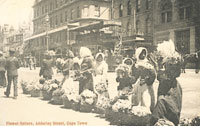 Flowers seller, Adderley Street, Cape Town. Franco Frescura Collection.
Flowers seller, Adderley Street, Cape Town. Franco Frescura Collection.
Other Muslims slaves were scattered across the town before emancipation, although a number of Muslim free Blacks were beginning to concentrate in the area on the slopes of Lion’s Rump later known as the Bo-Kaap. Other slaves settled in the Devils Peak area which already had an established community.
By 1840, Cape Town established its first municipality and the cluster of houses from Hanover Street to Lowry Street then became known as District 12. By 1849, the population rose considerably and the area expanded rapidly due to the emancipation of a number of slaves. Many ‘Malays’ settled here, a number of whom lived in the area above the open field in the vicinity of Muir Street.
This area was originally known as Kanaladorp. This name was a mixture of Maleyu and Dutch and mostly likely referred to people assisting each other, a community spirit: the literal meaning being 'if you please'. Early Kanaladorp was not only ethnically mixed but socially as well. In 1867, Cape Town was divided in six districts and Kanaladorp became the sixth district, henceforth people referred to the area as District Six.
District Six
District Six had a large concentration of 'Malay' people. This area was mainly a working class area. Living conditions varied enormously as you could find one family in a detached house while other house could contain up to 16 people in a single room.
Toilets were usually in the backyards and baths had to be taken in the kitchen in huge tubs. However, due to overcrowding, the area quickly turned into a slum area. In spite of this, there existed a joyous spirit and common bond amongst the inhabitants who had been living there for years. Sadly, in 1966, under the Group Areas Act, District Six was declared a ‘White’ area as government regarded the region as a health hazard to the city. As a result many ‘Malay’ people were moved along with others to the Cape Flats area.
Culture and traditions
The 'Cape Malays' have preserved their cultural identity and Islamic creed.
Language
The Afrikaans language evolved as a language of its own through a simplification of Dutch in order for the slaves to be able to communicate with the Dutch and amongst each other. Educated Muslims were the first to write texts in Afrikaans.
The 'Cape Malay' community generally speak mostly Afrikaans. English is used to a lesser extent, or local dialects of the two can also be heard. Although they no longer speak the Malay languages and other languages which their ancestors used, various Malay words and phrases can still be heard in Cape Town today for example: 'terima kasin' which is the Malay equivalent for 'thank you', and 'salmaat djalen' which is 'good journey to you'.
Home life
The 'Cape Malay' people follow Islamic principles of living. On Thursday nights, Malay people burn incense sticks (niang) in preparation for Friday.
Fasts and feasts
A feast to which relatives are invited to is known as a 'merang' and it is usually held to celebrate a special occasion. The following fasts and feasts are observed by all Malay people.
Moulood'n-Nabi (Birthday of the Prophet- PBUH)
This day is celebrated on the 12th day of Rabi-ul-Auwal. The prayers for this day are certain recitations from the Quran and songs that are sung in harmony. Women practice at least three months in advance for this ceremony. The Malay community celebrate by going to the mosque on the Saturday afternoon where they cut up orange leaves which are then dipped into sweet smelling oils and tied up in sachets. This is known as 'rampies sny'. At the evening prayer, at the mosque, sweetmeats are served and the little sachets of scented orange leaves are given out as gifts. This tradition which is believed to be of Indonesian origin gave the slaves a link to their ancestral home. The purpose of this ceremony is to send praises (salawat) to the Prophet (PBUH).
Mir'raj
This is a celebration in memory of the Prophet’s (PBUH) journey in one night from Mecca to Majid Al-Aqsa (known as Jerusalem) and then to the 7th Heavens and back.
Roa
Roa is on the 15th of the Islamic month of Shabaan and is a feast of purification.
Ramadaan
The most important fast in the Muslim calendar is the month in which the revelation of the Koran began. All Muslims must observe it, except those who are ill, travellers, the old, women who are pregnant, and children under the age of puberty. The Muslim year is determined by the sighting of the moon and the fast commences by the new moon in the beginning of the ninth Islamic month. The Islamic months consists of 29 or 30 days, depending on the sighting of the moon and the Islamic New Year starts on the month of Muharram and ends with the month Thul-Haj. The ‘Malay’ community refer to this fast as 'poewasa'.
The most important day in the fast is the 27th night which is described in the Koran as the 'night of power'. It is said in the Koran that during this holy night the sins of the faithful are forgiven and the angels and souls of Heaven come down to earth to perform many miracles.
The Malay people clean their houses in preparation for this night and candles are lit (kers-opsteek).
Lebaran Ramadaan (Eid-al-Fitr)
The sighting of the new moon again brings the holy month of Ramadaan to an end. This day is celebrated by all Muslims around the world. The day begins early as the men go to the mosque for a special Eid prayer or 'Eid salaah'. Thereafter in their new clothes, families visit and greet each other. Gifts are exchanged and elaborate food is prepared for the day.
Lebaran Hadji (Eid-ul- Adha)
This feast is known throughout the Muslim world as Eid-al-Adha. It is held after the hajj pilgrimage. A sheep is sacrificed by families who can afford to do so and shared with the poor.
Malay Food
Popular amongst Malay people are dishes such as bredie, frikkadels, denningvleis, sabananvleis, pinangkerrie, sosastie and bobotie and although the ‘Malay ‘people have changed their diet, these dishes still seem popular at the Cape.
Stews, roasts and baked vegetables still form part of the Malay diet but the food is very peppery and spicy.
Contact with the Dutch colonists left it’s mark as many old Cape dishes such as 'melktert' and 'koeksisters' are still to be found in Malay homes.
Weddings
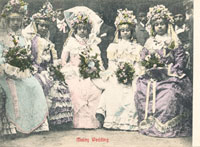 The Malay wedding. Franco Frescura Collection.
The Malay wedding. Franco Frescura Collection.
When a Malay man decides to get married, he asks his father to approach his prospective father in law and should they agree to the man’s hand in marriage then the couple become engaged or 'lambaar'. A time is fixed for the wedding and money 'maskowi' is paid to the bride to be. This money, which varies in amount, is according to the groom’s means and is paid to the priest who hands It over to the bride.
On the wedding day, the bride wears a 'medora' or headdress which is reminiscent of the golden ballets of Bali, and receives her guests in her first wedding dress. She does not attend the wedding ceremony which takes place at the mosque but is represented by her father or another male member of her family. A feast takes place usually for lunch at the bride family. Thereafter she changes her dress and joins the groom’s family for supper. At the end of the evening the bride is taken to her new home by her in laws or 'khujadi’s'.
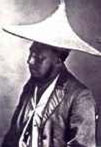 Straw hat-toedang.
Straw hat-toedang.
Early Malay dress
Early Malays wore a distinctive Mulsim style of dress: a toedang conical 'kopdoek' and the 'kaparring' wooden sandals, these originated in South-East Asia. Imams and others of higher status wore turbans.
The Khalifa
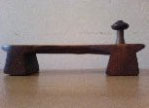 kaparang - wooden sandals.
kaparang - wooden sandals.
The Khalifa is a ‘Malay’ sword dance which takes place on the 11th day of Rabi-al-Agier in honour of Abdul Kadir Beker, a follower of the Prophet (PBHU). Its original religious implications have been modified with the result that the Khalifah now amounts to a skilful exhibition of sword play. Some Imams condone it as symbolic of the power of flesh over steel through faith, while others disapprove. The players, invariably state that they are aided by prayer.
Although the Khalifah or chalifah is the name of the central person conducting the ceremony, in South Africa it is often used for the ceremony itself. The Malay people used the word 'ratiep' for the actual performance. It is said that if one attends a Khalifa performance, one becomes conscious of the hypnotic effect which the rebanas have in conjunction with the rhythmic chanting, the incense and the general performance. For the rest skilful sword play explains unusual dance.
New Year's Carnival
Each year on the 2nd of January or 'Tweede Nuwe Jaar' the Bo Kaap celebrates a big street party, known as the 'Coon Carnival' in the centre of town. Originally, this was introduced by the Muslim slaves who celebrated their only day off work in the whole year. Nowadays men, woman and children march from the Grand Parade to the Green Point stadium. Plans for the parade are started a year in advance for the troupes that take part. Elaborate costumes are designed and sewn by ‘Malay’ tailors and are kept a secret until the day of the carnival as troupes are judged by their costumes, singing and dancing. Clad in colourful, shiny suits, hats and sun umbrellas, in true Rio Carnival style, the spirit and vitality of the Cape Minstrels continue to fascinate both tourists and locals alike. The 'Coon Carnival' has become one of the biggest events on the Cape Town calendar.
Music
This cultural group developed a characteristic type of Cape Malay music. One particular interesting secular folk song type, of Dutch origin, is termed the nederlandslied. The language and musical style of this genre reflects the history of South African slavery. Often, it is described and perceived as 'sad' and 'emotional' in content and context. The nederlandslied shows the influence of the Arabesque (ornamented) style of singing which is unique in South Africa, Africa and probably in the world.
Conclusion
Remnants of the old ‘Malay’ culture is still to be found in Cape Town today as a thriving Cape Malay community lends character to the mother city of South Africa. Cape Malay architecture, food (such as bobotie and yellow rice, samoosas, rotis, etc.), tailor shops, mosques and the warmth and hospitality of the Malay people continue to attract tourists in abundance to the mother city. Malaysians and Indonesians are starting to visit Cape Town in increasing numbers to experience this cultural link for themselves.